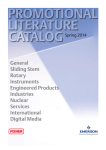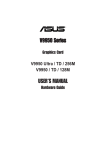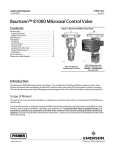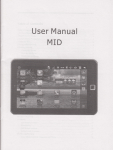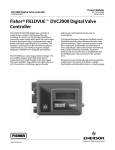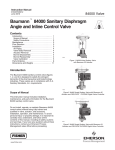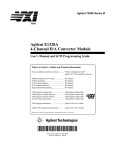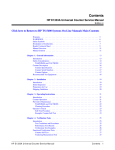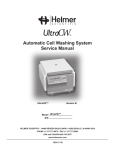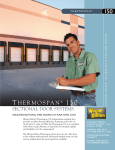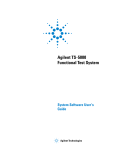Download Emerson Fisher Baumann 83000 Instruction Manual
Transcript
Instruction Manual 83000 Valve D103367X012 December 2014 Baumann™ 83000 Sanitary Angle Control Valve Contents Figure 1. Baumann 83000 Control Valve Introduction . . . . . . . . . . . . . . . . . . . . . . . . . . . . . . . . . . . 1 Scope of Manual . . . . . . . . . . . . . . . . . . . . . . . . . . . . . 1 Safety Precautions . . . . . . . . . . . . . . . . . . . . . . . . . . . 2 Educational Services . . . . . . . . . . . . . . . . . . . . . . . . . 2 Maintenance . . . . . . . . . . . . . . . . . . . . . . . . . . . . . . . . . 3 Installation . . . . . . . . . . . . . . . . . . . . . . . . . . . . . . . . . . 3 Air Piping . . . . . . . . . . . . . . . . . . . . . . . . . . . . . . . . . . . 4 Flow Direction . . . . . . . . . . . . . . . . . . . . . . . . . . . . . . 4 Disassembly . . . . . . . . . . . . . . . . . . . . . . . . . . . . . . . . 4 Lapping Sealing Surfaces . . . . . . . . . . . . . . . . . . . . . . 5 Bonnet Maintenance . . . . . . . . . . . . . . . . . . . . . . . . . 5 Valve Body to Bonnet Assembly . . . . . . . . . . . . . . . . 5 Calibration . . . . . . . . . . . . . . . . . . . . . . . . . . . . . . . . . 5 Parts Ordering . . . . . . . . . . . . . . . . . . . . . . . . . . . . . . . . 6 Dimensions and Weights . . . . . . . . . . . . . . . . . . . . . . 10 W9848 83000 Sanitary Angle Valve with Baumann 16 Actuator W9849 83000 Sanitary Angle Valve with FIELDVUEt DVC2000 Digital Valve Controller Introduction The Baumann 83000 Sanitary angle control valve (figure 1) features a packless design and is intended for laboratory flow rates as low as 0.001 liters per minute (l/m) with a Cv range of 0.00001 to 1.2. This innovative design also allows for clean-in-place (CIP) and sanitize-in-place (SIP) procedures and is self-draining. Meets 3-A sanitary standards for design and fabrication. Scope of Manual This instruction manual includes installation, maintenance, and parts information for the Baumann 83000 sanitary angle control valve. Do not install, operate, or maintain Baumann 83000 control valves without being fully trained and qualified in valve, actuator, and accessory installation, operation, and maintenance. To avoid personal injury or property damage, it is important to carefully read, understand, and follow all the contents of this manual, including all safety cautions and warnings. If you have any questions about these instructions, contact your Emerson Process Management sales office before proceeding. www.Fisher.com 83000 Valve Instruction Manual December 2014 D103367X012 WARNING Always wear protective gloves, clothing and eyewear when performing any installation operations to avoid personal injury. Personal injury or property damage caused by sudden release of pressure or bursting of pressure retaining parts may result if service conditions exceed those for which the product was intended. To avoid injury or damage, provide a relief valve for over pressure protection as required by government or accepted industry codes and good engineering practices. Check with your process or safety engineer for any additional measures that must be taken to protect against process media. If installing into an existing application, also refer to the WARNING at the beginning of the Maintenance section in this instruction manual. CAUTION This valve is intended for a specific range of pressures, temperatures and other application specifications. Applying different pressures and temperatures to the valve could result in parts damage, malfunction of the control valve or loss of control of the process. Do not expose this product to service conditions or variables other than those for which the product was intended. If you are not sure what these conditions are you should contact your Emerson Process Management sales office for more complete specifications. Provide the product serial numbers (shown on the nameplate) and all other pertinent information. WARNING If you move or work on an actuator installed on a valve with loading pressure applied, keep your hands and tools away from the stem travel path to avoid personal injury. Be especially careful when removing the stem connector to release all loading on the actuator stem whether it be from air pressure on the diaphragm or compression in the actuator springs. Likewise take similar care when adjusting or removing any optional travel stop. Refer to the relevant actuator Maintenance Instructions. Educational Services For information on available courses for the Baumann 83000 sanitary angle control valve, as well as a variety of other products, contact: Emerson Process Management Educational Services - Registration Phone: 1-641-754-3771 or 1-800-338-8158 E-mail: [email protected] http://www.emersonprocess.com/education 2 Instruction Manual 83000 Valve D103367X012 December 2014 Maintenance WARNING Avoid personal injury and property damage from sudden release of process pressure or bursting of parts. Before performing any maintenance operations: D Do not remove the actuator from the valve while the valve is still pressurized. D Always wear protective gloves, clothing, and eyewear when performing any maintenance operations. D Disconnect any operating lines providing air pressure, electric power, or a control signal to the actuator. Be sure the actuator cannot suddenly open or close the valve. D Use bypass valves or completely shut off the process to isolate the valve from process pressure. Relieve process pressure on both sides of the valve. Drain the process media from both sides of the valve. D Depending on the actuator construction, it will be necessary to manage the pneumatic actuator spring pre-compression. It is essential to refer to the relevant actuator instructions in this manual to perform safe removal of the actuator from the valve. D Use lock-out procedures to be sure the above measures stay in effect while you work on the equipment. D Check with your process or safety engineer for any additional measures that must be taken to protect against process media. Note Whenever a gasket seal is disturbed by removing or shifting gasketed parts, install a new gasket during reassembly. This provides a good gasket seal because the used gasket may not seal properly. WARNING Avoid personal injury or property damage by thoroughly cleaning the line of all dirt, welding chips, scale, oil or grease, and other foreign material. Failure to do so could result in parts damage, malfunction of the control valve or loss of control of the process. Installation 1. Before installing the valve in the pipeline, thoroughly clean the line of all dirt, welding chips, scale, oil or grease, and other foreign material. A micron size filter is recommended upstream of the valve. 2. Install the valve so that the controlled fluid will flow through the valve body in the direction selected from the guidelines shown below. 3. A three-valve bypass must be used to permit removal of the control valve from the line without shutting down the system. 4. A pressure gauge or other telltale connection should be installed in the 1/8 inch port in the bolted yoke (see figure 7). This gauge tells when leakage or breakage of the diaphragm has occurred. 3 83000 Valve Instruction Manual December 2014 D103367X012 WARNING To avoid personal injury or property damage, do not attempt to do any work on a valve while the system is in operation, the valve must be isolated 100% from the active system and the isolated line voided of pressure and/or hazardous fluids. Air Piping 1. For an air-to-extend actuator (air-to-close action), connect the actuating air pressure line to the 1/4 NPT opening in the upper diaphragm case. For an air-to-retract actuator (air-to-open action) connect the actuating air pressure line to the 1/4 NPT in the lower diaphragm case. See figures 4 and 5. 2. Use 6.4 mm (1/4 inch) O.D. tubing or equivalent for all air lines. If the air line exceeds 8 m (25 ft) in length, 9.5 mm (3/8 inch) tubing is preferred. Air lines must not leak. Air pressure should not exceed 2.5 bar (35 psig). Flow Direction There are two possible ways to pass fluid through the valve: in the Flow-to-Open mode, fluid enters through Port B and flows to Port A (see figure 2). In the Flow-to-Close mode, fluid enters through the port leading into the chamber or body bowl, Port A to port B. See figure 2 for port identification. Each flow direction has its advantages and disadvantages. The following guide will make a selection easier. Use Flow to Open: Port B to A D When the valve has to fail close in case of bursting or damage to sealing diaphragm. D When the valve must drain from inlet to outlet. (Valve mounted with actuator horizontal.) Use Flow to Close: Port A to B D In vacuum applications, vacuum on down stream. D With fluids that have a tendency to cavitate. D When a self-cleaning operation is required for removal of solid particles in the flow stream. Disassembly WARNING If there is evidence of process fluid under pressure leaking from the joint, retighten the valve body/joint nuts and return to the Warning at the beginning of the Maintenance section to provide proper steps have been taken to isolate the valve and relieve process pressure. 1. Remove the actuator by unscrewing the yoke drive nut (key 9) and lifting off the complete actuator assembly. This keeps the actuator assembly intact and calibrated to the factory setting. Refer to actuator instructions. 2. Remove the bolts (key 13) and lift the bonnet yoke assembly (key 2) with the diaphragm (key 5) and O-ring (key 15) from the valve body (key 1). 4 Instruction Manual 83000 Valve D103367X012 December 2014 3. Remove the O-ring (key 15) and diaphragm (key 5). Wipe with a clean soft cloth and examine for wear. 4. Inspect the valve body sealing surfaces. Refer to the Lapping the Valve Seat procedure in this instruction manual. Lapping Sealing Surfaces If valve leakage becomes excessive, it may be necessary to lap the sealing surfaces. 1. Use a good quality lapping compound with a mixture that contains 280 to 600 grit. Apply at several spots around the valve body sealing surfaces (refer to figure 6). 2. Thoroughly lap the valve body (key 1) on a flat, preferably cast iron, surface plate. 3. Clean the seats thoroughly after lapping. 4. Inspect the diaphragm (key 5) and replace if necessary. Bonnet Maintenance 1. Remove the actuator by unscrewing the yoke drive nut (key 9) and lifting off the complete actuator assembly. Hold the flattened portions of the bonnet yoke (key 2) in a vise and unscrew the valve bonnet (key 8) using a 2-1/4 inch wrench. Remove and inspect the bearing cartridge assembly (key 4) and O-ring (key 49). 2. Reinsert the parts, O-ring (key 49) and bearing cartridge assembly (key 4), ensuring the bearings extend below the side plate of the bearing cartridge assembly (key 4) and contact the piston subassembly (key 3). With the plunger (key 10) removed, screw the bonnet (key 8) onto the yoke (key 2). There should be no binding or galling. Tighten the bonnet with a wrench until there is metal-to-metal contact. 3. Insert the plunger (key 10) and push it in and out. The piston subassembly (key 3) should travel easily up and down. Valve Body to Bonnet Assembly 1. Place the diaphragm (key 5) in the bonnet yoke (key 2) cavity. 2. Place the O-ring (key 15) on the diaphragm (key 5) in the cavity. This should hold the diaphragm in place while assembling. 3. Place the bonnet assembly onto the valve body (key 1). 4. The locking screw (key 13) will thread through the bonnet yoke (key 2) and tighten into the valve body (key 1). Calibration 1. Reassemble the valve by inserting the O-ring (key 15) and diaphragm (key 5) into the valve body. 2. Replace the bonnet yoke assembly (key 2) and install the bolts (key 13) and tighten. Add the jam nut (key 27) and travel indicator disk (key 58) to the plunger (key 10). Place the drive nut (key 9) over the plunger (key 10). Line up the plunger (key 10) in the bearing cartridge assembly (key 4). Screw the actuator onto the plunger (key 10) until the actuator yoke touches the bonnet (key 8). Lock the actuator with the drive nut (key 9). Do Not Attempt to Rotate the Plunger (key 10) CAUTION To prevent damage to the plunger (key 10) or bearing cartridge subassembly (key 4), be sure the hex jam nut (key 27) is not tightened against the travel indicator (key 58). 5 83000 Valve Instruction Manual December 2014 D103367X012 1. For an air-to-retract actuator (air-to-open/fail closed). Apply 6.9 bar (100 psi) air pressure (or N2) to the normal valve inlet A. Apply 0.2 bar (3.2 psi) air signal to the actuator. Add 0.07 bar (1 psi) signal to the actuator if the inlet pressure exceeds 6.9 bar (100 psi). If the valve leaks, slowly turn the actuator stem counterclockwise. This will move the plunger (key 10) down until leakage is below 1 cc/min. Lock the plunger (key 10) in position with the jam nut (key 27). Calibrate the travel scale and check for 12.7 mm (1/2 inch) valve travel; apply a 1.04 bar (15 psi) signal. Reverse the signal; the plunger should move in the opposite direction with less than 0.014 bar (0.2 psi) signal change. 2. For an air-to-extend actuator (air-to-close/fail open), use the same procedure as in step one, except apply 0.88 bar (12.8 psi) to the actuator to calibrate the shut off position. Note For Baumann 16 actuator ONLY. For inlet pressures exceeding 10.6 bar (150 psi), 12.77 mm (NPS 1/2) or 20.7 bar (300 psi), 6.35 mm (NPS 1/4), use a positioner or I/P transducer with an output pressure of 0.07 - 1.2 bar (1-17 psi) (ASME-FCI Standard 87-2) to ensure the valve will close properly. Parts Ordering When corresponding with your Emerson Process Management sales office about this equipment, always mention the valve serial number. When ordering replacement parts, also specify the key number, part name, and desired material using the following parts tables. WARNING Use only genuine Fisherr replacement parts. Components that are not supplied by Emerson Process Management should not, under any circumstances, be used in any Fisher valve, because they may void your warranty, might adversely affect the performance of the valve, and could cause personal injury and property damage. 6 Instruction Manual 83000 Valve D103367X012 December 2014 Figure 2. 83000 for Baumann 16 Actuator SEE DETAIL IN FIGURE 3 PORT B PORT A E1332 Figure 3. 83000 with Stem Adaptor for Baumann 32 Actuator E1333 7 83000 Valve Instruction Manual December 2014 D103367X012 Table 1. Common Parts PART NUMBER KEY NUMBER QUANTITY DESCRIPTION 1 1 Valve Body Refer to table 2 2 1 Bonnet Yoke 81305 3 1 Piston Subassembly 81188 4* 1 Bearing Cartridge Subassembly 81180-2 5* 1 7* 8 Baumann 16 Actuator Baumann 32 Actuator Closure Diaphragm, 316 Stainless Steel 81148 Closure Diaphragm, N10276 Nickel Alloy 81148-1 1 Wave Spring 81401 1 Bonnet 81205 9 1 Drive Nut, (Yoke) 011757-003-153 10* 1 Plunger 11 1 Actuator Stem Adapter for Baumann 32 Actuator 13 2 Locking Bolt (refer to figure 8) 14* 1 15* 1 Refer to table 2 --- 81932 81173 O-Ring, Plunger 81147 O-Ring, Body (FKM) 81165-5 O-Ring, Body, (EPDM) 81165-6 O-Ring, Body, (PTFE) 81165-8 27 1 Hex Jam Nut, Baumann 16 Actuator 49* 1 O-Ring, Bonnet 58 1 Travel Indicator Disk 81841 971514-002-250 81206 011765-002-152 24299 Table 2. Baumann 83000 Valve Body and Plunger PLUG TRAVEL DIAPHRAGM TRAVEL 83000 VALVE BODY (KEY 1) PLUNGER (KEY 10) Cv Kv mm Inch mm Inch ≤30 Ra Microinch ≤20 Ra Microinch Baumann 16 Actuator Baumann 32 Actuator 0.014 0.012 0.686 0.027 0.1778 0.007 81664 81664-1 81193 (5_)(1) 81933 (5_)(1) 0.053 0.046 1.60 0.063 0.1778 0.007 81663 81663-1 81193 (5_)(1) 81933 (5_)(1) 0.182 0.157 3.81 0.150 0.1778 0.007 81661 81661-1 81193 (5_)(1) 81933 (5_)(1) 0.427 0.367 3.81 0.150 0.3810 0.015 81661 81661-1 81192 (13_)(1) 81931 (13_)(1) 0.631 0.543 9.40 0.370 0.0005 0.012 81657 81657-3 81191 (8_)(1) 81934 (8_)(1) 81657-3 81192 (13_)(1) 81931 (13_)(1) 1.02 0.877 1. Degree of angle cut on the plunger. 8 ORIFICE DIAMETER 9.40 0.370 0.3810 0.015 81657 Instruction Manual 83000 Valve D103367X012 December 2014 Figure 4. Air-to-Extend (Air-to-Close Action) Figure 6. Seating (Sealing) Surfaces 1/4 NPT OPENING E1370 Figure 5. Air-to-Retract (Air-to-Open Action) W9918 Figure 7. 1/8 Inch Port 1/4 NPT OPENING W9919 E1234 9 83000 Valve Instruction Manual December 2014 D103367X012 Figure 8. Baumann 83000 - Rotated View to Show Locking Bolts PREFERRED MOUNTING (for outlet drain) NORMAL FLOW DIRECTION PORT B E1334 Figure 9. Valve Body Subassembly Figure 10. 83000 with Baumann 16 Actuator and FIELDVUE DVC6000 Digital Valve Controller 159 (46.25) 212 (8.35) 146 (5.76) 87 (3.41) TRI-CLAMP FITTINGS 30 (1.20) E1335 10 96 (3.79) mm (inch) E1336 NPS 1/2 VALVE 41 (1.63) mm (inch) Instruction Manual 83000 Valve D103367X012 December 2014 Figure 11. Baumann 16 Actuator with Fisher 3660/3661 Positioner and 67CFR Airset 129 (5.1) 159 (46.25) 93 (3.7) 125 (4.9) 39 (1.6) 146 (5.76) 67CFR mm (inch) 3660/3661 POSITIONER E1331 Figure 12. Baumann 16 Actuator with FIELDVUE DVC2000 Digital Valve Controller Figure 13. Baumann 16 Actuator with FIELDVUE DVC2000 Digital Valve Controller, Top View 159 (6.3) 83 (3.3) 127 (5.01) 175 (6.9) 166 (6.52) mm (inch) E1328 166 (6.52) E1330 mm (inch) Note The actuator requires 115 mm (4-1/2 inches) of vertical clearance. 11 83000 Valve Instruction Manual December 2014 D103367X012 Table 3. Baumann 83000 Valve Weight Table 4. Baumann Actuator Weights VALVE SIZE: 12.7 mm (NPS 1/2) BAUMANN 16 BAUMANN 32 kg lbs kg lbs kg lbs 1.82 4 2.1 4.6 4.5 10 Neither Emerson, Emerson Process Management, nor any of their affiliated entities assumes responsibility for the selection, use or maintenance of any product. Responsibility for proper selection, use, and maintenance of any product remains solely with the purchaser and end user. Baumann, Fisher, and FIELDVUE are marks owned by one of the companies in the Emerson Process Management business unit of Emerson Electric Co. Emerson Process Management, Emerson, and the Emerson logo are trademarks and service marks of Emerson Electric Co. All other marks are the property of their respective owners. The contents of this publication are presented for informational purposes only, and while every effort has been made to ensure their accuracy, they are not to be construed as warranties or guarantees, express or implied, regarding the products or services described herein or their use or applicability. All sales are governed by our terms and conditions, which are available upon request. We reserve the right to modify or improve the designs or specifications of such products at any time without notice. Emerson Process Management Marshalltown, Iowa 50158 USA Sorocaba, 18087 Brazil Chatham, Kent ME4 4QZ UK Dubai, United Arab Emirates Singapore 128461 Singapore www.Fisher.com 12 E 2009, 2014 Fisher Controls International LLC. All rights reserved.












